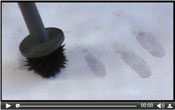|
View in browser: http://www.crime-scene-investigator.net/newsletter/1115.html
|
||
|
NOVEMBER 2015 | ||
|
Welcome to the November 2015 Crime Scene Investigator Network Newsletter
| ||
|
This Month's Featured Resource on the Crime Scene Investigator Network Website
|
||
 Just as today's law enforcement officer has learned to look routinely for fingerprints to identify the perpetrator of a crime, that same officer needs to think routinely about evidence that may contain DNA. Recent advancements in DNA technology are enabling law enforcement officers to solve cases previously thought to be unsolvable. Today, investigators with a fundamental knowledge of how to identify, preserve, and collect DNA evidence properly can solve cases in ways previously seen only on television. Evidence invisible to the naked eye can be the key to solving a residential burglary, sexual assault, or child's murder. It also can be the evidence that links different crime scenes to each other in a small town, within a single State, or even across the Nation. |
||
|
Featured Video Presentation
|
||
|
Watch this video to learn how to develop fingerprints using magnetic powder. |
||
|
New CSI and Forensic Job Announcements
|
||
|
The most comprehensive listing of Crime Scene Investigation and Forensic To be notified of job openings as they are posted, follow us on Twitter: Job Posting Alerts |
||
|
Crime Scene Investigator
City of Delray Beach Police Department, Florida, USA Final Filing Date: November 20, 2015 This is advanced technical work in crime scene investigation. Work involves processing of scenes, photography, evidence identification and collection with associated report preparation. <View complete job listing> |
||
|
Crime Scene Technician
City of Miramar Police Department, Florida, USA Final Filing Date: November 25, 2015 Conducts thorough crime scene investigations, including searching for, locating, collecting, identifying, processing, documenting and preserving physical evidence. Obtains casts or impressions of footprints, tire impressions and tool marks. Photographs/diagrams crime scenes, evidence and victims as necessary. Properly logs, stores, maintains and handles all evidence taken into custody. ... <View complete job listing> |
||
|
Criminalist — Laboratory Unit
Adams County Sheriff, Commerce City, Colorado, USA Final Filing Date: November 18, 2015 The Criminalist assigned to the Laboratory Unit is responsible for responding to crime scenes to collect, preserve, and document evidence, and to evaluate, examine, analyze and identify evidence collected. (physical evidence, photographs, video, sketches, documentation). <View complete job listing> |
||
 |
||
|
DNA Analyst III-Serology/DNA Ops Tech
Harris County Institute of Forensic Sciences, Houston, Texas, USA Final Filing Date: December 11, 2015 Performs scientific examination and analysis of biological evidence collected in connection with death and criminal investigations. Testing may also include screening for the presence of biological fluids and DNA analysis using Polymerase Chain Reaction/Short Tandem Restraints (PCR/STR) based methods. Analyst may be required to testify regarding analysis in a court of law as an expert witness in legal proceedings. ... <View complete job listing> |
||
|
Forensic Computer Examiner
Comal County Sheriff, New Braunfels, Texas, USA Final Filing Date: November 29, 2015 Forensic examination of computers. Forensic examination of cell phones and digital devices. Submit and retrieve evidence to and from the Property Room. Research and testing of new products, techniques and procedures relating to computer and cell phone technology. Prepares reports, presents and testifies to forensic evidence in official proceedings. Courtroom testimony. ... <View complete job listing> |
||
|
Forensic Scientist — Latent Prints
Nebraska State Patrol, Lincoln, Nebraska, USA Final Filing Date: November 30, 2015 Examine and/or process evidence to visualize/develop friction ridge detail; analyze, compare and evaluate friction ridge detail; photograph all latent prints; utilize Adobe Photoshop CS6 for digital latent image processing; compare received/developed latent impressions with known inked fingerprints, and/or enter latents into Automated Fingerprint Identification System (AFIS) for comparisons; ... <View complete job listing> |
||
|
Search for more job listings in Crime Scene Investigations and Forensics To be notified of job openings as they are posted, follow us on Twitter: Job Posting Alerts |
||
|
Other Resources on the Crime Scene Investigator Network Website
|
||
|
Not Subscribed to this Newsletter?
|
||
|
If you are not subscribed to this newsletter, you may subscribe with this link: SUBSCRIBE via email |
||
|
To Unsubscribe
|
||
|
To unsubscribe from future e-mail newsletters, please click here: UNSUBSCRIBE Copyright ©2015 Crime Scene Resources, Inc. Crime Scene Investigator Network |



